 Eighty years ago this month, the cover of the August 1938 issue of Radio Retailing carried this reminder for servicemen that good reception begins with a good antenna.
Eighty years ago this month, the cover of the August 1938 issue of Radio Retailing carried this reminder for servicemen that good reception begins with a good antenna.

 Eighty years ago this month, the cover of the August 1938 issue of Radio Retailing carried this reminder for servicemen that good reception begins with a good antenna.
Eighty years ago this month, the cover of the August 1938 issue of Radio Retailing carried this reminder for servicemen that good reception begins with a good antenna.
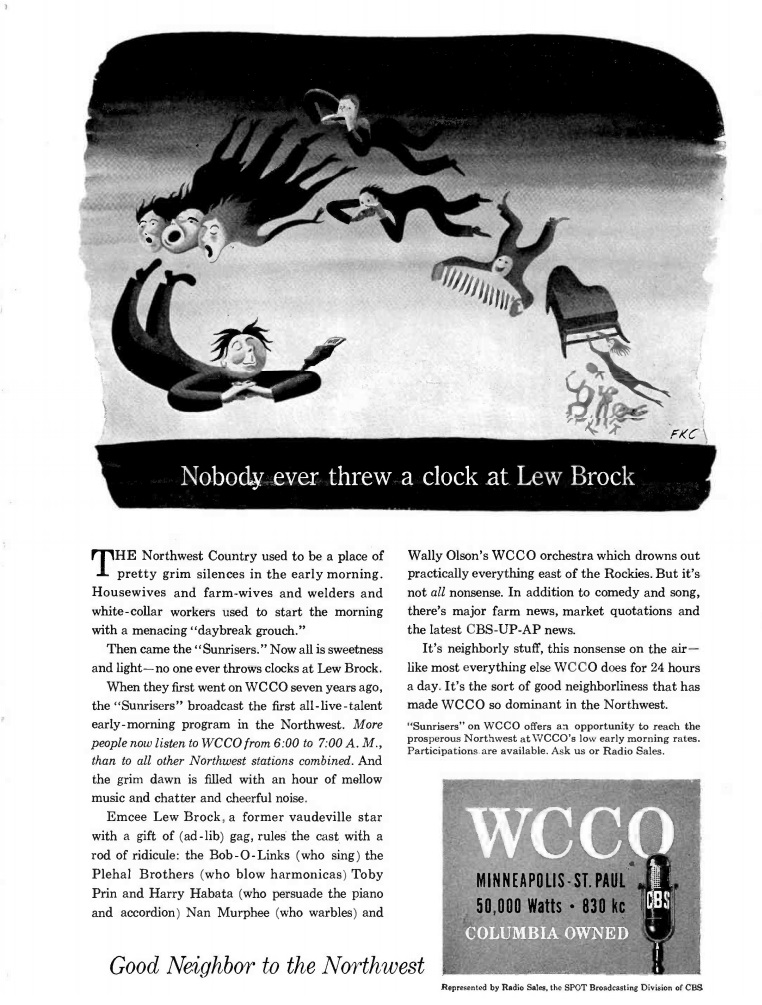 This ad for WCCO Minneapolis appeared in Broadcasting magazine 75 years ago today, August 30, 1943. It reminded advertisers that the station’s 6-7 AM program, time on which could be booked at the early morning rate, was hosted by Lew Brock, who had a loyal following with the station’s loyal listeners.
This ad for WCCO Minneapolis appeared in Broadcasting magazine 75 years ago today, August 30, 1943. It reminded advertisers that the station’s 6-7 AM program, time on which could be booked at the early morning rate, was hosted by Lew Brock, who had a loyal following with the station’s loyal listeners.
According to the ad, former vaudeville star Brock emceed the “Sunrisers” program, which included an orchestra and other musical regulars.
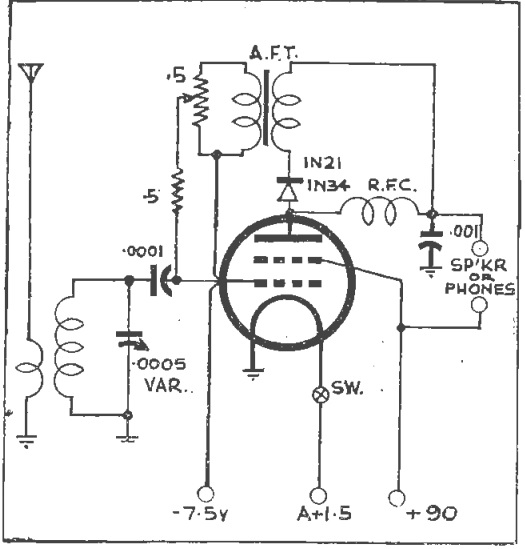 Seventy years ago this month, the August 1948 issue of the Australian magazine Radio Science carried this circuit for a one-tube reflex receiver capable of driving a speaker. The circuit called for a 1C3GT tube, but noted that any one-volt tube could be used with an adjustment of the bias voltage.
Seventy years ago this month, the August 1948 issue of the Australian magazine Radio Science carried this circuit for a one-tube reflex receiver capable of driving a speaker. The circuit called for a 1C3GT tube, but noted that any one-volt tube could be used with an adjustment of the bias voltage.
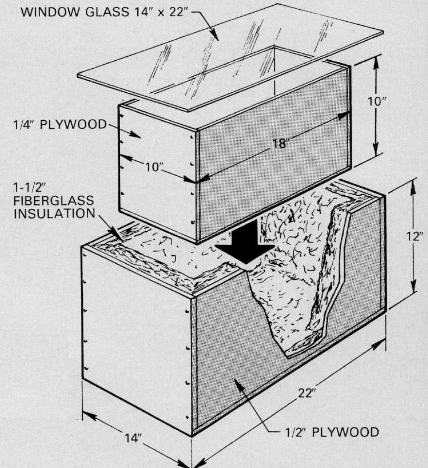 Forty years ago this month, the August 1978 issue of Boys’ Life carried these plans for a solar oven. According to the magazine, the oven would reach 200 degrees, “hot enough to cook a meat loaf or bake breads in several hours.” The inner and outer boxes were insulated with fiberglass insulation and sealed air tight. The inside of the inner box was painted black with a “non-lead” paint. Four shiny aluminum panels could be used to direct heat into the oven.
Forty years ago this month, the August 1978 issue of Boys’ Life carried these plans for a solar oven. According to the magazine, the oven would reach 200 degrees, “hot enough to cook a meat loaf or bake breads in several hours.” The inner and outer boxes were insulated with fiberglass insulation and sealed air tight. The inside of the inner box was painted black with a “non-lead” paint. Four shiny aluminum panels could be used to direct heat into the oven.
A suggested improvement to increase efficiency was to use a double layer of glass with an air gap between the two panes.
If you would prefer to have someone else do the construction work, the solar oven shown at left is you can find this solar oven Amazon which appears to have good reviews.
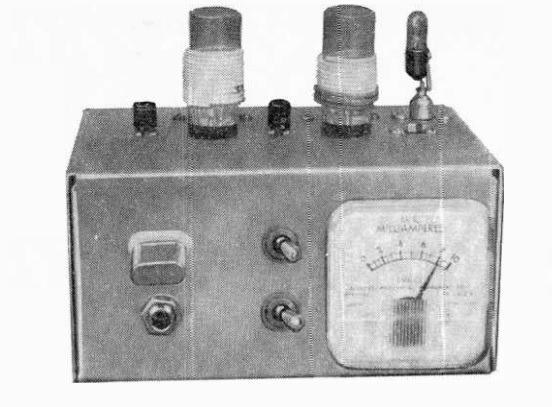 Sixty years ago this month, before QRP was cool, the August 1958 issue of Popular Electronics carried the plans for this QRP transmitter for 15, 11, and 10 meters. The set was dubbed the Semiconductor Space Spanner. The two-transistor transmitter had an input power of 96 milliwatts. The author, Don Stoner, W6TNS reported contacts all over the continent and as far away as Hawaii. While some of those contacts were pre-arranged, many were the result of a normal CQ.
Sixty years ago this month, before QRP was cool, the August 1958 issue of Popular Electronics carried the plans for this QRP transmitter for 15, 11, and 10 meters. The set was dubbed the Semiconductor Space Spanner. The two-transistor transmitter had an input power of 96 milliwatts. The author, Don Stoner, W6TNS reported contacts all over the continent and as far away as Hawaii. While some of those contacts were pre-arranged, many were the result of a normal CQ.
The cost of the parts was said to be $19, less crystal. A 40 meter crystal was used on 15 meters, although the circuit pulled the signal somewhat below the exact third harmonic.
The circuit used a 2N371 transistor as oscillator, feeding the 2N370 final amplifier.
If the author’s name looks familiar, readers will recall that he was the designer of an early CB rig which served as the prototype of the Heathkit CB-1 and “Benton Harbor Lunchbox” transceivers for 2, 6, and 10 meters.
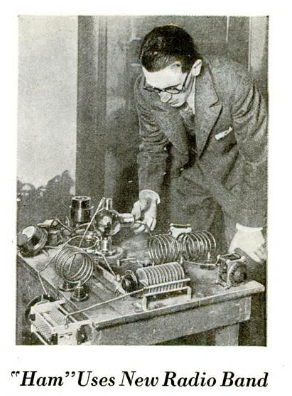 Shown here in the August 1928 issue of Popular Science is Upper Montclair, NJ, ham Charles K. Atwater (no relation to Atwater Kent) with his 10 meter transmitter. According to the magazine, Atwater had added another triumph for the hams, namely use of the “remarkably low wave length of ten meters.” With his low powered transmitter, he established two-way contact with two stations on the Pacific coast, and had earlier made contact with Arachon, France. The French contact was apparently with F8CT, as recounted on this page.
Shown here in the August 1928 issue of Popular Science is Upper Montclair, NJ, ham Charles K. Atwater (no relation to Atwater Kent) with his 10 meter transmitter. According to the magazine, Atwater had added another triumph for the hams, namely use of the “remarkably low wave length of ten meters.” With his low powered transmitter, he established two-way contact with two stations on the Pacific coast, and had earlier made contact with Arachon, France. The French contact was apparently with F8CT, as recounted on this page.
Atwater had been a ham for a while, since he was listed in the 1916 callbook and 1921 callbook with the call sign 2JN, with an address of 40 Oakwood Avenue, Upper Montclair, NJ.
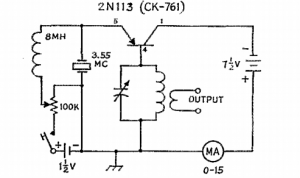 He remained active, as shown by this one-transistor transmitter circuit he submitted (with his call now W2JN) in the December 1955 issue of QST.
He remained active, as shown by this one-transistor transmitter circuit he submitted (with his call now W2JN) in the December 1955 issue of QST.
According to QCWA, Atwater died in 1980.
 A hundred years ago, the entrepreneur couldn’t go wrong by getting into the lucrative battery charging business, as shown by this ad in the August 1918 issue of Popular Science.
A hundred years ago, the entrepreneur couldn’t go wrong by getting into the lucrative battery charging business, as shown by this ad in the August 1918 issue of Popular Science.
The unit appears to be a gasoline-driven six-volt 500 watt generator, capable of charging one to seven auto batteries at a cost of 13-15 cents per battery. The ad reports that autoists would pay $0.75 – $1.50 for the service, meaning that garage owners were clearing $40 – $60 extra profits per month.
The set was available from Hobart Brothers Co. of Troy, Ohio, for $15 down plus nine payments of $20 each. The company is still in business, today focused on the welding industry.
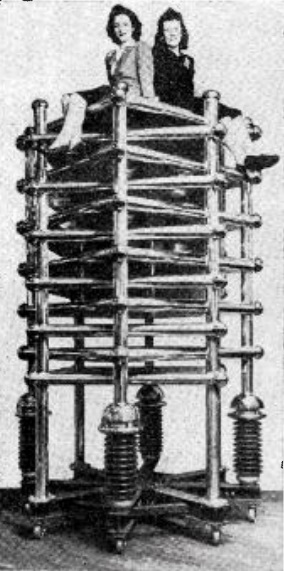 This a 2500 pF (2.5 nF) 200,000 volt capacitor, as shown 75 years ago today in the August 23, 1943, issue of Broadcasting.
This a 2500 pF (2.5 nF) 200,000 volt capacitor, as shown 75 years ago today in the August 23, 1943, issue of Broadcasting.
The part was manufactured by Federal Telephone & Radio Corp., and the magazine notes that it was constructed without strategic aluminum. The twelve plates were hollow, 3-1/3 inches thick, made of 16 gauge sheet steel welded together at the sides.
According to the magazine, the part was used in the company’s high-powered transmitter laboratories as a “phantom antenna capacitor,” which presumably means that it was part of a very large dummy load.
The same picture also appears in the May 1944 issue of Popular Science,
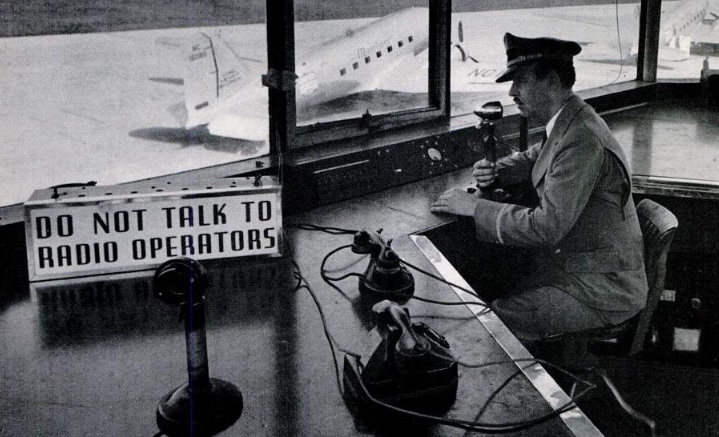 This sensible advice appeared in Life magazine 80 years ago today, August 22, 1938. If someone attempts to distract this Chicago air traffic controller by engaging in idle chit chat, he merely needs to point to the sign.
This sensible advice appeared in Life magazine 80 years ago today, August 22, 1938. If someone attempts to distract this Chicago air traffic controller by engaging in idle chit chat, he merely needs to point to the sign.
 Here’s a snapshot of grocery prices 60 years ago today, as shown in this ad from the August 21, 1958, issue of the Milwaukee Journal. You can click on the image above for a full-size image.
Here’s a snapshot of grocery prices 60 years ago today, as shown in this ad from the August 21, 1958, issue of the Milwaukee Journal. You can click on the image above for a full-size image.
The prices look cheap, but keep in mind that there’s been a lot of inflation in the last sixty years, and the money is no longer backed by silver. One way to compare pre-1964 prices is to remember that one dollar could be in the form of one silver dollar, four silver quarter, or ten silver dimes, all of which equaled approximately one ounce of silver. The price of silver today is approximately $15 per ounce, meaning that to compare, you should multiply the prices by 15 to get the approximate price in today’s money.
Another way to compare prices is to look at the minimum wage. In 1958, the federal minimum wage was $1 per hour, but now it is $7.25 per hour. To use this metric to compare prices, you would multiply the prices shown here by $7.25.
The following chart shows the 1958 prices of various items, and the adjusted prices using each metric. Finally, it shows the price of a comparable product at Walmart.
|
Product |
1958 Price |
Adusted for Silver Value |
Adjusted For Minimum Wage |
2018 Walmart Price |
|
T-Bone Steak, per pound |
$0.99 |
14.85 |
7.18 |
9.48 |
|
Rump Roast, per pound |
$0.89 |
13.35 |
6.45 |
4.97 |
|
Corned Beef, 12 oz. can |
$0.41 |
6.15 |
2.97 |
3.12 |
|
Spam, 12 oz. can 0
|
$0.47 |
7.05 |
3.41 |
2.64 |
|
Beef stew, 24 oz. can
|
$0.45 |
6.75 |
3.26 |
2.18 |
|
Butter, 1 lb.
|
$0.79 |
11.85 |
5.73 |
3.24 |
|
Ice cream, 1/2 gal.
|
$0.89 |
13.35 |
6.45 |
2.97 |
|
Coffee, 1 lb.
|
$0.69 |
10.35 |
5.00 |
3.65 |
|
Chicken noodle soup |
2/$0.25 |
1.88 |
1.08 |
1,48 |
|
Pork & Beans, 16 oz.
|
2/$0.25 |
1.88 |
1.08 |
1.48 |
|
Tomato soup
|
$0.11 |
1.65 |
0.91 |
1.58 |
|
Crackers, 1 lb. |
$0.33 |
4.96 |
2.39 |
1.78 |
By clicking the Walmart prices above, you can view the product and its current price, which might have changed from the price shown. Links on this page are affiliate links, meaning that if you make a purchase after clicking the link, this website receives a small commission.
For a look at other prices through history: 1939 prices, 1956 prices.